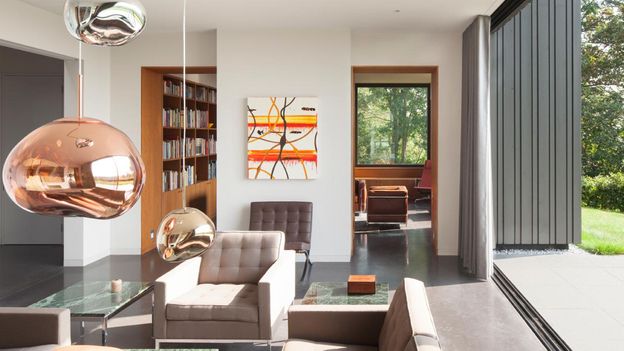
Danish interior design studio Space Copenhagen also links indoors and out when dreaming up minimalist interiors. “We prefer sheer fabrics for curtains and blinds that allow for outside daylight to filter softly into spaces,” says Signe Bindslev Henriksen, co-founder of the company, who sums up its style as “poetic modernism”. She tells BBC Culture: “Translucency avoids creating a hard boundary between inside and outside. Overall, we choose natural, tactile, organic materials – wood, stone, leather, linen, warm-toned metals and exposed plaster – and subdued, earthy colour tones.”
For David Montalba, founder of Montalba Architects, which has offices in Los Angeles and Lausanne, Switzerland, integrating views of the surrounding landscape into a minimalist home is essential to making it feel warm. “The landscape can be a house’s rural setting or a courtyard with paving and planting, as found within a triple-height atrium at our project Vertical Courtyard House in LA,” says Montalba, who grew up in Switzerland and the Carmel area of California. He is influenced by the Southern Californian regionalist architecture of Irving Gill, whose early 20th-Century houses featured simple interiors, plain fireplaces and skylights, and George Brook-Kothlow, who incorporated an abundance of wood into his houses. “Engaging with the outdoors helps soften a minimalist home, as do bookshelves, art and textiles. In one living space at Vertical Courtyard House, a wall-hung textile piece by Canadian artist Brent Wadden adds warmth and texture.”
Comfort zone
And interior designer Rukmini Patel has created a warmly minimalist living room for a home in Stratford-upon-Avon, using colours and materials inspired by nature. “My client, who has a house with a garden, expressed a wish for the interior to connect with the outdoors,” she says. “When creating a cosy minimalist home, I feel it’s important to use a multitude of natural materials, textures and colours that engage the senses. For the living room I chose autumnal tones – rust, burnt orange and olive green – and wicker and wood to evoke nature. I opted for wood flooring, echoing this with wood, rather than colder metal or glass furniture, and a warm peachy cream shade for the walls. I also plumped for a thick, tactile Berber rug that is calming and relaxing when you sink your feet into it.”
Smith believes a warmly minimalist interior can be achieved simply by combining a limited number of contrasting textures: “Play with the juxtaposition of opposites as transitioning from one to the other heightens the senses. Imagine walking barefoot on a hard smooth floor, then stepping on to a soft textured rug, and the feeling of warmth and luxury that brings.”